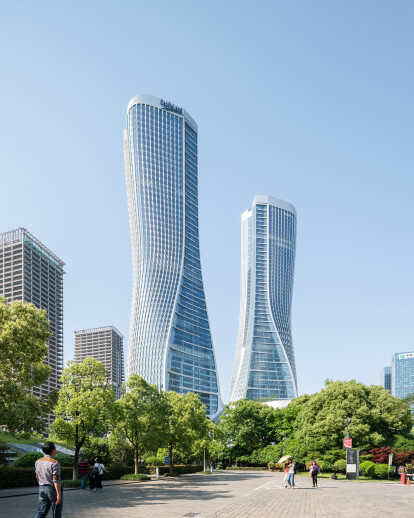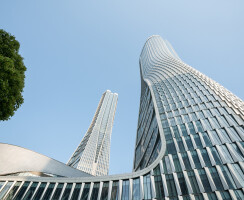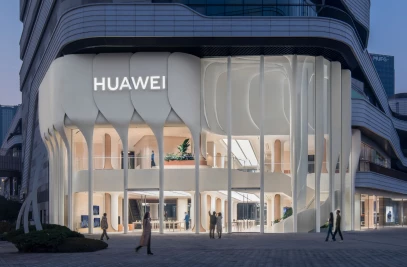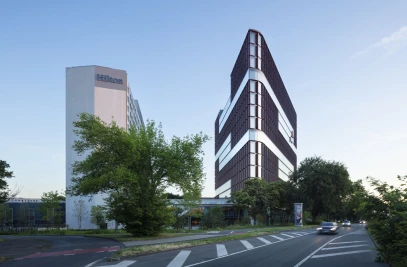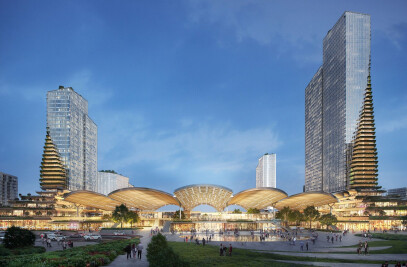15-Nov-2017 Designed by Ben van Berkel / UNStudio, CapitaLand’s new Raffles Cityis a sustainableurban hub for living, working and leisure located in Hangzhou, one of China’s most picturesque cities.It forms the eighth Raffles City developmentin China.
Situatedin Qianjiang New Town near Qiantang River, this mixed-use development becomes a major landmark along the green axis of the city’s new CBD.Arich mixof 24/7 functions occupiesalmost 400,000m2within two streamlinedtowers set atop apodium and landscaped plaza.
Conceived as a lively vertical neighbourhood and transit hub and featuring stunning views of the river and West Lake areas, the sixty-storey, 250 metre-tallhighrises contain residential units,Grade A offices, theConrad Hotel and a rooftophelipad; the 116,000m2six-storeypodium accommodates retail, restaurants, leisure facilities and parking and hasa direct underground connection to the metro.
“Raffles City Hangzhou will be a point of confluence, a hub for business conduct and a new destination for visitors and residents alike; an ‘all-in-one’ destination for working, living and leisure in a highly sustainable environment.”
Ben van Berkel Capital of Zhejiang province,the city is steeped in tradition with a view to the future. Located 50 minutes by high-speed train from Shanghai, Hangzhou has become an economic powerhouse within China today thanks to a strong tech sector. While the city’s heritage focuses on the picturesque UNESCO heritage-listed West Lake, its future points to a new economic, political and cultural centre orientated towards the river.With strong future ambitions especially concerning sustainability, economy and livability, Hangzhou is a city on the move.
In light of the impacts of urbanisation worldwide,UNStudioposed the question: How can we utilise a dense, mixed programmeas part of a transit-oriented development to stimulate sustainable living and improve quality of life?
Mixed-use: Healthy future cities The project furthers the practice’s ongoing research into Superliving, in this case into (integral) strategies to create sustainable, healthy cities that offer a high quality of life, while addressing future needs for greater efficiency and density in cities in times of rapid urbanisation and growth. The building is designed with a carefully considered mix of programmes - like those found in a good city - that bring together a wide range of users. Besides working and living at Raffles City, people can stay at the hotel, or pick up groceries, enjoy a meal, do exercise, watch a movie or even get married there, all in one interconnected environment.
As such it not only provides residents and those working or staying in the complex with a healthy and socially integrated environment, it also ensures that programmes are active around the clock, creating a safe and lively neighbourhood for all.
Landscape Informed by the city’s famed natural landscape,UNStudio’sdesigncreates a local identity for Raffles City, while celebrating its trademark ‘city within a city’ concept.Reflecting the movement in the river, the tower design features a wave-like motion. These concentric waves increase in their dynamism, starting calmly at the base and building up more vigorously along the vertical axis. These formal expressions enabled us to connect the wide variety ofprogrammes throughout the building into one seamless flow.
The design contributes to the landscape character of this green city. Situated diagonally opposite the civic centre, the corner site borders both the urban built-up context andgreen axis/city parkthat connects West Lake to the Qiantang River.
The architecture of the two towers consolidates these two contexts in one gesture whereby the urban face of the building twists towards the landscape, while the landscape aspect, in turn, acknowledges the urban context. The towers are not identical but, rather, complementary, as ifengaging in dialogue.
The plan is organised as two diagonal and intersecting figure-of-eights. Positioned on opposite corners, each tower consists of an ‘urban facade’ that frames the urban corner of the site, and a horizontally articulated ‘landscape facade’ that descends into the inner courtyards at podium level.
The main entrance to the south appearsas a prominent gateway from the city park and civic centre. The east-west orientationof the towers minimises overshadowing whilemaximising daylight for the residences and offices.
Articulation The design of thetower and podium facadesinterplay contrasting textures. Clad in a shimmering scale-like skin of aluminium tiles, thepodium facadesreflect the building’s activity and landscape to offer pixelatedperspectives. The towers feature an outer layer of rotated, vertical solar shading fins, placed atop the curtain wall system. Accentuating the tower’s characteristic twist, they also frame internal views. Catching thelight throughout the day,the lines of panels add a luminous texture to the facade. By night the curvilinear silhouette lights up: this reinforcesthe building’s prominenceand minimisesthe building’slight pollution as only the outline is illuminated.
Interior Situated at the centre of the retail spine, a spectacular atrium forms the organisational and visual focus of the podium interior. The atrium is designed as a spiral of overlapping layers, creating seamless connectivity and extensive sightlines between the spaces.
As a feature detail the bamboo handrail echoes the building’s curvilinear form. Winding its way around the podium as a continuous ribbon, it adds an element of tactility and natural contrast with the futuristic interior.
From here two diagonal voids ascend seven storeys through the opposite wings of the retail spine. As an intuitive finding device, the voids guide visitors along each wing that spans almost 150 metres in each direction. Abundant daylight streams through the atrium and voids right down to the lowest floors, introducing a unique outdoor quality to the podium interior.
Looking up through the skylights, the towers are always visible from the main atrium, changing appearance depending on the viewing point. As the scale of the fluid forms transition from the architecture to the streamlined interior and winding handrails, this results in a cohesive spatial experience – as if outside merges with inside.
Sustainability An inclusive approach to sustainability is integral toUNStudio’s design philosophy. The incorporation of natural ventilation, solar gainand daylighting principles tailored to the local context,efficient structure and the ways in which materials are employed all work in concordance with one another to lower the energy and material demands of the building.Raffles City Hangzhou is the first retail mall in China to use natural ventilation on a large scale and has achieved Gold LEED certification.
Withsocial sustainability in mind, the programme mix creates a dynamic, continuous 24/7 cycle of activity that encourages public participation and engagement.
31-May-2010 Unstudio’s mixed-use Raffles City development is located near the Qiangtan River in Hangzhou, the capital of Zhejiang province, located 180 kilometres southwest of Shanghai. With a city population of 1.69 million, Hangzhou is one of the most renowned and prosperous cities in China and is well known for its beautiful natural scenery, particularly in the West Lake area.
UNStudio’s Raffles City in Hangzhou will be CapitaLand’s sixth Raffles City, following those in Singapore, Shanghai, Beijing, Chengdu and Bahrain. UNStudio’s Raffles City Hangzhou incorporates retail, offices, housing and hotel facilities and marks the site of a cultural landscape within the Quianjiang New Town Area.
According to Ben van Berkel, “The philosophy behind the Raffles City concept is to integrate mixed use in an urban context, but in such a way as to give this concept a twist; by focussing on where the urban context meets the landscape of the city. In the design of the towers the urban element of the project twists towards the landscape, whilst the landscape aspect, in turn, twists towards the urban context, thereby effecting the incorporation and consolidation of these separate elements in one formal gesture.”
Raffles City Hangzhou is due for realisation in 2012. After four years of planning and construction, it will reach a height of 60 stories, presenting views both to and from the Qiantang River and West Lake areas. Raffles City Hangzhou will provide a total floor area of almost 300,000 square metres.
In the chain of events and attractions of Hangzhou, like the West Lake area and the commercial centre, the Raffles City project will be at the core of the Qianjiang New Town area and contribute to the recognition of this area as a new destination in the city.
Ben van Berkel says of the project, "I believe it will have a sizable impact, as it is a project with a very strong identity and an individual character, which means it will become a place to which people would like to return. It is a project which communicates both with the architecture and within the context of Hangzhou as a city, for this reason we believe it will be a very unique building in China.”
Sustainable design principles An inclusive approach to sustainability is an important part of UNStudio’s design philosophy. In the Raffles City project UNStudio seeks to receive the gold certification from the Leadership in Energy and Environmental Design (LEED) Green Building rating system, the industry standard for rating of the eco-friendliness of buildings.
The incorporation of natural ventilation principles and the ways in which materials are employed, all work in concordance with one another to lower the energy and material demands of the building. Urban sustainability is also an important consideration in the design. The programme mix creates a dynamic, continuous 24/7 cycle of activity, a hub for business conduct, a new destination for visitors and residents alike and will become an all-in-one destination for working, living, leisure and entertainment.
